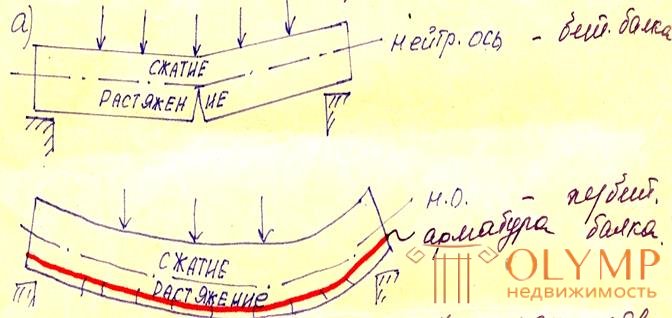
.
Reinforced concrete is a building material in which concrete and steel (reinforcement) are connected into a monolithic whole.
The idea of creating reinforced concrete from two materials that are different in their mechanical characteristics is the real possibility of using concrete for work at a construction site, and steel in tension.
Concrete is an artificial stone, resists stretching 10-15 times weaker than compression, often significantly limits the possibilities of its use. If, for example, a concrete beam,

free lying on two supports, bend, then the upper fibers of the beam will be compressed, and the lower ones will be stretched. Since concrete is poorly resistant to stretching, cross section, such a beam can be assigned only from the working conditions of the concrete in tension, therefore the concrete beam will be massive and inefficient. If in rast. enter a small amount of steel (1-2% of the concrete concrete section), then the bearing capacity of the beam will increase by 10-20 times.
The joint work of concrete and reinforcement in reinforced concrete structures was possible due to the advantageous combination of the following properties:
1) Coupling (gluing) m. Concrete and the surface of the reinforcement that occurs during the hardening of the concrete mix;
2) The protection of reinforcement, enclosed in the body of concrete, from corrosion and direct exposure to fire.
The advantages of reinforced concrete.
·: Due to its high physicomechanical properties, it has a significant resistance to static and dynamic loads,
· Vibration resistant, durable, fire resistant and well resistant to weathering.
· Up to 70 - 80% of the mass of the reinforced concrete material are widely used materials (sand, gravel or crushed stone and water);
· The strength of concrete over time not only does not decrease, but even increases;
· Can easily give any appropriate constructive and architectural forms.
The disadvantages of reinforced concrete.
· A relatively large mass of structures;
· Increased heat and sound conductivity;
· The complexity of the work, especially in winter;
· The need for qualified personnel, special equipment;
· The possibility of cracks before application of the operational load due to shrinkage and creep of concrete.
Reinforced concrete can be used in industrial, residential and rural construction, in hydrotechnical, thermal and nuclear construction.
Что бы оставить комментарий войдите
Комментарии (0)